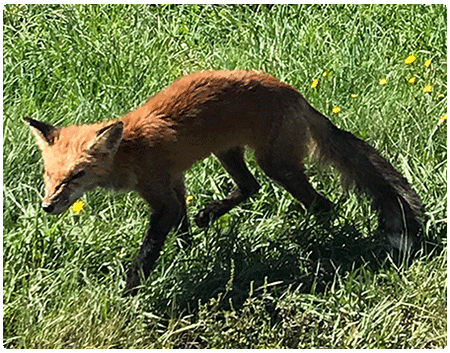Do not feed wildlife or attempt to treat wildlife with medicine!
What is Mange?
Mange is a highly contagious skin condition caused by burrowing mites that affects wildlife worldwide.
Here are the basics:
- Not all hair loss and/or crusting is caused by mange. Proper diagnosis of mange requires skin scrapings and microscopic identification of the mite species.
- In some cases, mange can be fatal, debilitating an infested mammal through hair loss, damaged skin, secondary infections, and starvation.
- There are different species of mites that can cause mange, some of which are species-specific.
- Stressors influence severity and duration of infection. Most individuals recover from mange, which helps protect them from future mange infestations. For example, a lactating coyote may look terribly infected with mange, but will likely recover after the pups are weaned and the additional stressors on this coyote are decreased.
- Mange is likely density-dependent, meaning that higher numbers of individual animals in an area increases the number of mites and thus, the likelihood of mange spreading.
- Sarcoptic mange is zoonotic, meaning that mange can be transmitted to humans.
Do not feed wildlife or attempt to treat wildlife with medicine:
- Wildlife feeding contributes to the spread of mange and other diseases by bringing individuals in close contact, leading to increased spread of disease agents. While wildlife diseases occur naturally, disease spread is significantly increased when wildlife concentrations are increased at artificial feed sites.
- Bravecto requires a prescription from a licensed veterinarian and when prescribed, must be administered to the prescribed animal at the labeled dose.
- Animals with mange may have (or develop) secondary infections and/or nutritional deficiencies that are not overtly apparent by appearance alone. Treating only the mite infestation does not address other conditions.
- Treatment should only occur in animals under direct and close supervision by veterinarians to ensure complete treatment and appropriate dosing. Incomplete treatments (e.g., one dose) without supportive care may result in animals becoming reinfested with mites. Re-infection is possible even if the initial dose(s) appears to be effective.
- Bait piles are not appropriate, because treatment of mange requires proper diagnosis (by skin scrapings and microscopic identification of the mite) and knowledge of the weight and other health factors of the animal.
Too much medication can lead to medical complications, including toxicity, and underdosing (too little medication or an incomplete course of medication) may lead to medication-resistant mites.
Further, the ingestion of small doses can be lethal to some non-target wildlife and cause detrimental health issues in others. Some species of birds, amphibians, and reptiles (and some domestic dog breeds) are susceptible to negative health impacts, including death, from mange medications, including ivermectin. - The use of any drug that cannot be dosed precisely or that does not follow the indicated treatment course, particularly in species for which it is not approved, sets the stage for resistance. For example, Ivermectin drug resistance has been observed in sheep and recently, in humans.
- Natural immunity depends on infection. Many wild animals can recover from mange without treatment, which allows the animals to develop natural immunity to future mite infestations. Natural infections play a role in natural selection and evolution of resistant animals; by treating these animals, we remove the evolutionary pressure that allows them to develop resistance to the mites.
